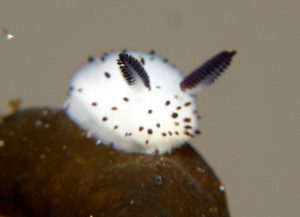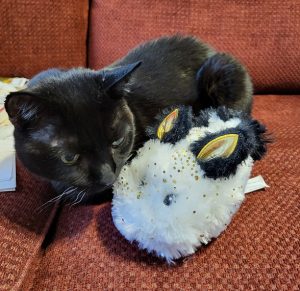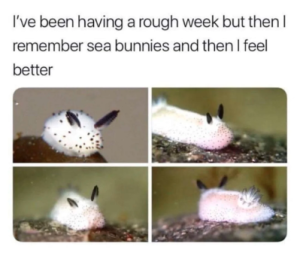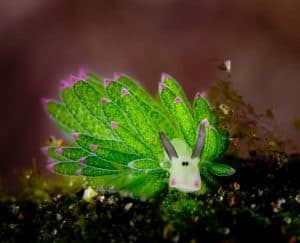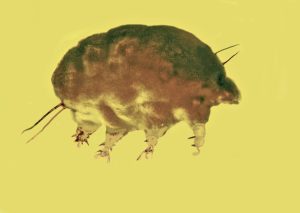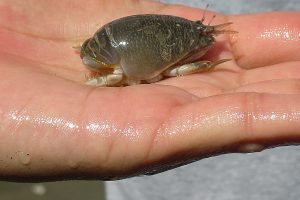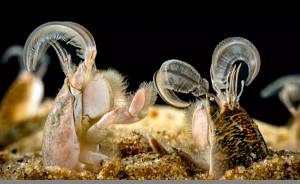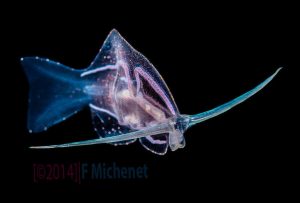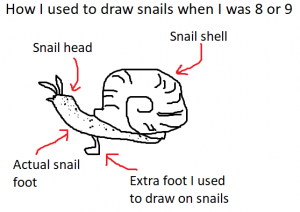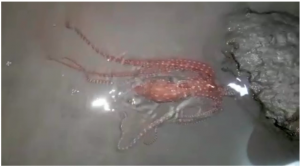Podcast: Play in new window | Download (Duration: 22:11 — 22.9MB)
Subscribe: | More
This week we’re looking at some really strange animals…or are they plants? Or both? We’ll start with the sea anemone, then learn about a sea slug that photosynthesizes like a plant (sort of), then learn a little about whether algae is a plant or an animal…and then we’re off and running through the wild world of carnivorous plants–including some carnivorous plants of mystery!
Thanks to Joshua Hobbs of A Degree in Nonsense for the suggestion, and to Simon for the article link I’ve already managed to lose!
A sea anemone and some actual anemones. Usually pretty easy to tell apart:
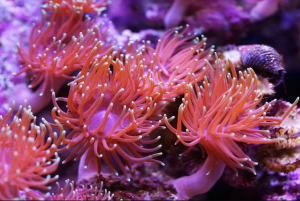
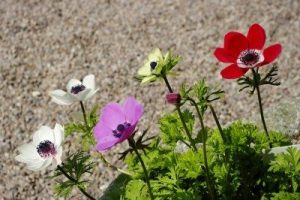
The sea onion looks so much like an onion I can’t even stand it. This is an ANIMAL, y’all!
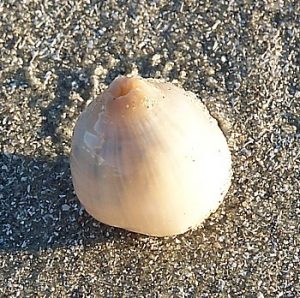
Venus flytrap sea anemone and actual Venus flytrap. It’s usually pretty easy to tell these two apart too.
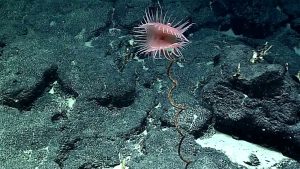
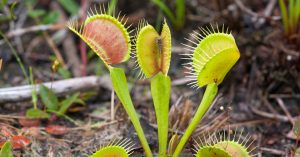
The eastern emerald elysia, a sea slug that looks and acts like a leaf:
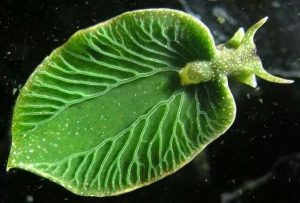
Giant kelp. Not a plant. Actually gigantic algae. Algae is neither a plant nor an animal:
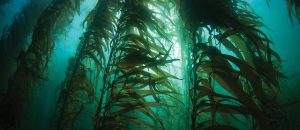
The corpse flower (left) and the corpse lily (right). Both smell like UGH and both are extremely BIG:
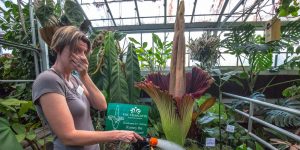
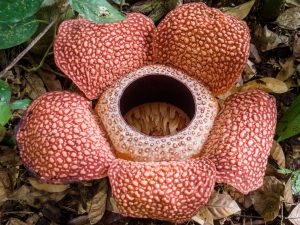
The pitcher plant can grow very big:
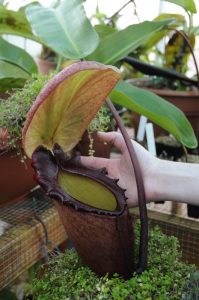
Maybe don’t go near trees with a lot of skulls around them:
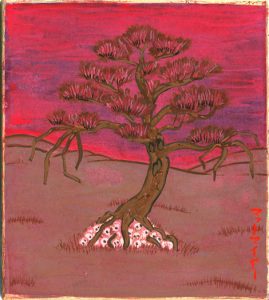
Puya chilensis (the clumps in the foreground are its leaves; the spikes in the background are its flower spikes):
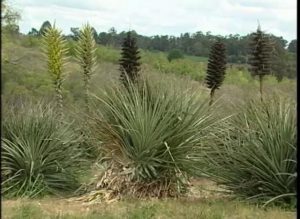
Show transcript:
Welcome to Strange Animals Podcast. I’m your host, Kate Shaw.
This week we’re going to explore the sometimes blurry line between animals and plants. Joshua Hobbs of a great new podcast A Degree in Nonsense suggested a type of carrion flower that smells like rotting flesh to attract insects, and friend of the pod Simon sent me an article about carnivorous plants. Our very first Patreon bonus episode was actually about carnivorous plants, so I’ve expanded on that episode and added lots of interesting new content. Buckle up, folks, because we’re going to cover a whole lot of ground today!
Oh, and Joshua also says, quote, “I never had a pet growing up, but recently gained an interest in animals. Now after getting into your podcast and animal YouTube channels, I’ve got my first pet, a little corn snake named Arnold!” So welcome to podcasting, Joshua and Arnold!
Let’s start by looking at an animal that resembles a plant. The sea anemone looks so much like a plant that it was named after an actual flower, the anemone, but the sea anemone is related to jellyfish. Most sea anemones attach to a rock or other hard surface most of their lives and don’t move much, although they can creep along very slowly—so slowly that snails are racecar drivers in comparison. Many species have a body shaped like a plant stem and colorful tentacles that resemble flower petals. But those tentacles aren’t just to look pretty. The sea anemone uses them to catch prey. The tentacles are lined with stinging cells that contain venom, just like many jellyfish have. The venom contains neurotoxins that paralyzes a fish or other small animal so that the sea anemone can eat it.
So how does something that looks like a plant eat a fish?
The sea anemone has an interesting body plan. What looks like the stem of a plant is called the column, and in some species it’s thin and delicate while in other species it’s thick like a tree trunk. It sticks to its rock or whatever with an adhesive foot called a basal disc, and on the other end of the column is what’s called the oral disc. Oral means mouth. The actual mouth is in the middle of the oral disc, surrounded by tentacles. The mouth is usually shaped like a slit, which if you think about it is sort of how people’s mouths are too. The digestive system is inside the column. But there is no other opening into the body. The mouth is it. So like jellyfish, the mouth takes in food but it also expels waste, so, you know, not precisely a mouth like ours. When the sea anemone wants to eat, it uses its tentacles to push the food into its mouth.
You know the movie Finding Nemo? Nemo and his dad are clownfish, which aren’t affected by sea anemone venom. Clownfish hide among sea anemone tentacles so predators won’t bother them. In return, the sea anemone eats the clownfish’s poops. I wish I were making that up.
If a sea anemone feels threatened, many species can not only suck its tentacles into its mouth, it can retract the whole mouth inside its body. Basically, it can swallow its own mouth. A sea anemone called the sea onion retracts its tentacles and inflates its column so that it looks like an actual onion. The sea onion lives in a burrow it digs very slowly into the sediment at the bottom of the ocean, with just its tentacles sticking out.
Most sea anemones live in relatively shallow water, but there are some deep-sea species. The Venus flytrap sea anemone has been found at 5,000 feet deep, or over 1,500 meters. At first glance looks like a Venus flytrap plant, thus the name. Its body is a long, usually slender column that widens into a big oral disc on top that’s fringed with short tentacles. It mostly eats detritus that drifts down from above, which it filters from the water with its tentacles, although if a living creature strays into its tentacles it’ll eat it too.
That brings us to the actual Venus flytrap. It’s a plant that eats insects and spiders, especially crawling insects like ants and beetles. The ends of its leaves are modified into lobes that look a little like flowers because the insides of the lobes are a cheerful red while the edges and the hair-like cilia are yellow. When a bug touches the receptors inside the lobes it closes tightly. If the insect continues to move around inside, stimulating the receptors even more, the lobes seal and form a sort of stomach. Digestive enzymes are secreted and about ten days later the lobes reopen and there’s nothing left of the insect but its empty exoskeleton.
If bugs made movies, this would be the subject of every single bug horror film.
The Venus flyptrap is only found in one small part of the world, the boggy areas surrounding Wilmington, North Carolina in the United States. They’re so in demand that the plant is almost extinct in the wild due to idiots digging them up to sell. But Venus flytraps really aren’t that difficult to grow, you just have to make sure the soil you use is deficient in nitrogen and phosphorus. So you can buy Venus flytraps that were grown ethically instead of dug up from the wild. As of 2014 digging up a Venus flytrap is a felony in North Carolina.
Before we go on to talk about some other carnivorous plants, let’s discuss an animal that acts like a plant. It’s a sea slug called the eastern emerald elysia and it lives along the east coast of North America in shallow water. Even though it’s a sea slug, it will also live in fresh water. It grows to about an inch long, or 3 cm, and is green. It’s green because it photosynthesizes like a plant…sort of.
The sea slug eats algae, but it doesn’t fully digest the algae it eats. Its digestive system retains the algae’s chloroplasts, which are the parts of a plant cell that convert sunlight into energy, which is what photosynthesis is. The sea slug keeps the chloroplasts in its digestive system and keeps them alive for months, living off the energy the chloroplasts produce. Researchers aren’t sure how the sea slugs keep the chloroplasts alive.
This is pretty amazing, but it’s not the only sea slug that photosynthesizes in this way. The blue dragon sea slug, that lives along coasts around the Indo-Pacific Ocean, doesn’t just keep chloroplasts alive to produce chlorophyll energy. It gets even more complicated about it. The blue dragon eats tiny animals called hydrozoa, which are related to jellyfish and include the freshwater hydra, although since the blue dragon only lives in the ocean it doesn’t actually eat the hydra. The blue dragon eats hydrozoa that themselves contain a type of microscopic algae that live in a lot of animals, like giant clams, some jellyfish, even some sea anemones, and exchange energy from photosynthesis for protection from predators by living in or on its host. So when the blue dragon eats the hydrozoa containing these algae, it retains the algae and keep them alive. So basically it gets to eat its prey and steals its prey’s symbiotic algae.
Speaking of algae, most algae photosynthesize, and in fact many seaweeds, like kelp, aren’t plants but are giant plant-like algae. But algae, technically, aren’t plants. They’re not animals either. Researchers and taxonomists are still working out the ways various algae are related to each other and to other organisms, but most algae are considered more closely related to plants than to animals without actually being plants. They’re usually grouped with plants above the kingdom level of taxonomy, but since at that level animals like humans and fish and worms and mosquitoes are grouped with fungi, this is a really broad category.
And that brings us, in a roundabout way, to the rotten meat smelling plant suggested by Joshua. There are several plants that attract flies and other insects to pollinate their flowers by smelling of rotten meat. Some of these have freakishly large flowers, like the corpse flower. It lives in rainforests in parts of Sumatra and Java and is actually related to the calla lily. It’s a weird-shaped plant and hard to describe. You know how a calla lily has a pretty white petal that wraps around a yellow spike thing? The corpse flower is like that, only it can be ten feet high, or 3 meters. The thing that looks like a petal is actually a specialized leaf and the yellow spike is called the spadix. The yellow part is made up of tiny flowers, so a calla lily isn’t a single flower, it’s lots of flowers that look like one. Well, the corpse flower is like that, although its flowers are actually only at the bottom of the spadix. The petal-like leaf is dark red inside. The top of the spadix is where the rotten smell comes from, and it’s incredibly stinky—something like rotting meat and rotting fish with some extra smell like dung on top of it. It releases this stink mostly in the evenings and the top of the spadix actually grows hot to better disperse the smell.
The largest single flower in the world is sometimes called the corpse lily and it can grow over three feet across, or about a meter. It’s dark reddish-brown with white speckles and five fleshy petals, which look like meat. It smells like rotting meat too. Flies are attracted to the flower, which pollinate it. The flower can take an entire year to develop but only blooms for a few days. If it’s successfully pollinated, the flower produces a round fruit full of seeds that are eaten by tree shrews, which later poop the seeds out and spread them.
But the corpse lily isn’t any ordinary plant. It doesn’t even have roots or a stem or leaves. All it has is the flower, which grows directly from the roots of the corpse lily’s host plant. That’s right, the corpse lily is a parasitic plant, but it’s no ordinary parasite. It grows not on or around its host plant, but inside it. The host plant is a type of vine called Tetrastigma, related to the grape vine. When a tree shrew poops out a seed, the seed germinates and if it happens to germinate on a Tetrastigma vine, it develops tiny threadlike filaments that penetrate the vine and grow inside it.
The corpse lily lives only in the rainforests of Borneo and Sumatra, and it’s rare and getting rarer since so much of the rainforests in those areas are being destroyed. Fortunately, the corpse lily is actually a tourist attraction since it’s so rare, so spectacular, and so stinky. People who have corpse lilies growing in their yard sometimes protect the flower buds from harm and charge tourists to come look at them, which helps the people of the area and the plants.
There are literally hundreds of carnivorous plant species, with carnivorous habits evolving probably nine different times among plants that aren’t related. Different species use different methods to catch insects. For instance, the pitcher plant has modified leaf that forms a slippery-sided pitcher filled with nectar-like liquid. When an insect crawls down to drink the liquid, it falls in. The insect drowns and is dissolved and digested.
Some carnivorous plants have leaves lined with sticky mucilage, which traps small insects. The sundew has tentacles lined with hair-like structures beaded with mucilage. When an insect becomes trapped in the mucilage, the tentacles bend toward the insect and stick onto it, sometimes quite quickly—in seconds, or in at least one species, a fraction of a second. Generally you don’t think of plants as moving that fast.
Almost all known carnivorous plants are pretty small. The largest are pitcher plants. Two species of big pitcher plants grow in the mountains of the Philippines. Attenborough’s pitcher plant was discovered in 2007 and described in 2009, and is a shrub with pitchers that can hold nearly two liters of fluid. An even bigger pitcher plant was discovered in 2010. But the biggest pitcher plant known is from a couple of mountains in Malaysian Borneo called Nepenthes rajah. It’s been known to science since 1858 and its pitchers can hold over 2 ½ liters of digestive fluid. The biggest pitcher ever measured was over 16 inches tall, or about 41 cm, and the plant itself is a messy sort of vine that can grow nearly 20 feet long, or 6 meters. Mostly pitcher plants just attract insects, but these giant ones also trap frogs, lizards, rats and other small mammals, and even birds.
There’s always the chance that even bigger pitcher plants have yet to be discovered by science, although probably not much bigger than the ones we do know about. The larger an animal, the more likely it is to damage the pitcher while trying to escape. Insects and the occasional small animal are fine, anything bigger than that could just bust through the leaf.
But there have long been rumors about plants that eat much larger animals, even humans. In the 1870s, a German explorer named Karl Liche claimed he’d witnessed a tribe in Madagascar sacrifice a woman to a carnivorous tree. His account is not very believable. He describes the tree as about eight feet high with a thick trunk. A coat of leaves hang down from the top of the tree, leaves about twelve feet long with thorns. At their base is a flower-like receptacle with sweet liquid inside, with six ever-moving tendrils stretching up from it. When the sacrificial woman was made to drink the liquid, the tendrils wrapped around her and the tree’s long leaves folded up and over her. After ten days, the leaves relaxed, leaving nothing but a bleached skull at the base of the tree.
Later expeditions to Madagascar never found any plant that resembled Liche’s. In fact, everyone who’s researched Liche, the tribe he mentioned, and the tree in question haven’t found any evidence that any of them ever existed. It turns out that the account was a hoax from start to finish, written by a reporter named Edmund Spencer for a newspaper called the New York World in 1874.
A 1924 book called Madagascar: Land of the Man-Eating Tree describes a more realistic-sounding carnivorous plant that was supposed to be from India. Its blossoms have a pungent smell that attracts mice and sometimes large insects, which crawl into a hole in the blossom that turns out to be a bristly trap. This sounds a little like the corkscrew plant that lives in wet areas of Africa and Central and South America. It has ordinary leaves aboveground but modified leaves that grow underground. The modified leaves are traps with a stalk lined with hairs pointing in one direction. Tiny water animals, especially single-celled protozoans, stray into the leaves but can’t get out because of the hairs. They’re digested and absorbed by the leaves. But there are no known corkscrew plants or anything like them that trap larger animals or animals that live aboveground.
An 1892 article describes a friend of a friend of a friend’s encounter with a tangle of thin, willow-branch-like vines covered with an incredibly sticky gum. This was supposed to have happened in Nicaragua in Central America. A Mr. Dunstan’s dog was ensnared by the plant but was rescued by Dunstan, who managed to cut the vines with his knife. In the process, both man and dog suffered blistered injuries from the plant, as though it had been trying to suck their blood. The article also says that natives of the area say the plant will reduce a lump of meat to a dried husk in only five minutes.
From these sorts of factual-seeming accounts, it’s a short step to plants of folklore like the Japanese Jubokko tree that grows on battlefields and drinks human blood. It captures people who pass too close to it, sticks its branches into them, and sucks out their blood. If someone cuts into the tree’s bark, blood comes out instead of sap.
Another carnivorous plant was supposedly encountered by a French explorer in 1933 in the jungles of southern Mexico. He doesn’t describe the plant in his 1934 magazine article, just says it’s enormous, but he does say that when a bird alighted on one of its leaves, the leaf closed and pierced the bird with long thorns. The expedition’s guide called it a vampire plant.
A similar story supposedly of a plant found in South America and Central Africa is of a short tree with barbed leaves that grow along the ground, and if an animal or bird steps on the leaves they twine around it and stab it to death, then squeeze the blood out to absorb.
There may actually be a real plant that these stories are based on. It’s called the Puya chilensis and it lives in Chile in South America, on dry hillsides of the Andes Mountains near the ocean. It’s an evergreen plant that only flowers after it’s some 20 years old, with a flower spike that can grow over 6 ½ feet high, or up to 2 meters. The flowers are pollinated by birds. But its leaves are long, edged with hooked spines, and grow in clumps that can be up to six feet wide, or nearly two meters.
Those hooks along the leaves give the plant its other name, the sheep-killer. Sheep and other animals can become entangled in the leaves, which are so tough that locals use the leaf’s fibers to make rope. If the animal can’t escape, it dies and its body decomposes, adding nutrients to the soil around the plant. Yum.
You can find Strange Animals Podcast online at strangeanimalspodcast.blubrry.net. That’s blueberry without any E’s. We’re on Twitter at strangebeasties and have a facebook page at facebook.com/strangeanimalspodcast. If you have questions, comments, or suggestions for future episodes, email us at strangeanimalspodcast@gmail.com. We also have a Patreon if you’d like to support us that way.
Thanks for listening!
